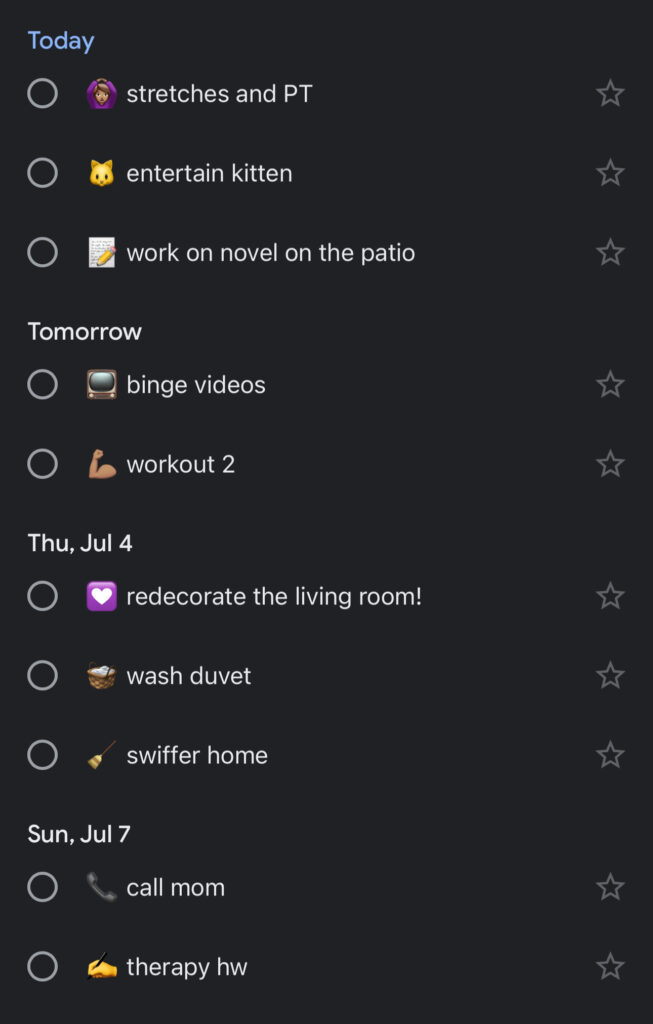
Hi! Welcome to the Delight Collective, my self-discovery blog. Finding reasons to start your healing journey can be a lot easier than actually starting it. If you’re reading this, you’re probably ready to move on from some aspect of your life. Maybe you’ve had a long streak of bad luck and you’re feeling down on yourself. Maybe you find yourself in a confusing pattern, sabotaging your relationships or opportunities that have come your way. Or maybe you just never found your place in life, and you’re worried about what the future holds for someone who has no driving passion. I’m here to tell you that it’s possible to find your drive, live your best life, and grasp happiness once and for all.
But first of all, who the hell am I? Well, I’m not a psychologist or any kind of trained professional. I’m just a person in the world who’s managed to build a life for myself that I’m not only proud of, but fulfilled by. I’m a 29-year-old woman who’s recovered from my eating disorder – controversial, I know – and sober-ish (California sober, anyone?). I’ve moved past a string of poor relationships, I live with my best friend in a world-class city, and I do work that fills my cup every day. I went from wondering how I was going to continue on with life in my early and mid-twenties to having more love, joy, and ambition than I ever could have imagined. I’ve found so many ways to make myself happy that it seems crazy not to share them. So, without further ado, let’s get on with starting your healing journey.
What is a “Healing” Journey?
First of all, I hate the idea of a “healing” journey. I know. Just bear with me. When we embark on a lifelong “healing” journey, the focus remains on wounds that need tending. While it’s important (essential, even) to contemplate your traumas and how they’ve impacted your life, I took a slightly different approach to changing my life that helped me feel better a lot faster. I want to say again that I’m NOT a psychologist, just someone who’s honed the art of the mindset and had great results.
“But Zarina,” you say. “I’ve been through a lot of bullshit. I have to deal with all that stuff before I can hope to live my best life, right?”
Well, sort of. Yes, maybe you do need to sit down with a therapist and take a serious look at your past. I think most people do. But that goes hand in hand with what I’m about to suggest. And that is… allowing space for another focus. Imagine that you’re in your palace of healing. You go into one room to look at the past and what’s harmed you. In that room, you process your pain and sit with your former selves. You speak to your inner child. You try to understand that what happened to you might not have been your fault, but it is your responsibility to recover from. This is a difficult room to be in. No one is meant to be in that room at all times. It’s too much.
Now, imagine another room…
This is where you go to watch an endless reel of all the nice little things that carry you from day to day. I’m not talking about graduation day or when you adopted your beloved pet. It’s stuff like seeing your email inbox zeroed out. Maybe when you get the last bunch of fresh basil at the store, or the last box of your favorite popsicles. It’s when someone compliments your outfit, or better, when you see yourself in the mirror and feel a jolt of “I look GOOD!” You need to visit both of these rooms in order to get on the path to your best life. That second room, where they’re playing that happy movie – the focus in that room is on this elusive little thing called delight.
Both healing from your past and nudging yourself towards delight are essential components in the recipe for sustainable happiness. So let’s get started on the flipside of a “healing journey” and get on this path that includes chasing your delight from day one. The benefits of self-discovery are numerous and have far-reaching effects on your quality of life. So let’s begin!

Okay, so what’s delight, really? And how is this different than a healing journey?
It might have been a long time since you actually registered delight. It’s not exactly something that we tend to focus on as humans. In fact, in a lot of ways, our brains are wired to focus on the negative. (Remember this next time you start beating yourself up for being such a negative Nancy). So let’s start with the good old dictionary definition of delight, the noun:
1: a high degree of gratification or pleasure : joy
also: extreme satisfaction
2: something that gives great pleasure
Merriam-Webster
Day-to-day, I tend to experience delight as a sudden, uplifting flush of pleasure. I feel it in the top of my head. You might feel it elsewhere, or differently. It strikes when a cute dog passes me by on the street, when a friend messages me, or when I prepare a delicious meal for myself.
How do you experience delight? When was the last time you did?
Bear in mind that the goal of taking this path is to hone your ability to identify and follow this feeling. If you can’t identify it right now, that’s okay. Just keep thinking about it, and one day, you’ll catch the feeling in the moment. Until then, let’s talk about…
Practical Steps to Get on the Delight Path (The New “Healing Journey”)
1. Grab a notebook and audit your life
Make a list of every “area” of your life and examine the pieces in each area. A live well lived includes growth and satisfaction in multiple areas. Consider which areas feel like they could use more focus, and keep an eye out for people, places, things, and ideas in each area that you find challenging You can choose to divide your life into any number of different areas, and you don’t have to consider all of them (but I urge you to include health). Maybe your life fits neatly into a few, or maybe you would like to expand into different areas. Here’s a list of life areas to get you started:
Some of these areas are more physical and tangible:
- Health: This is the foundation to all other areas of life, and includes physical and mental health. Do you experience pain regularly? Do you move your body on a regular basis? Are you able to consistently get a full night’s rest? Do you have any mental health symptoms that affect you daily? How is your relationship with food? When was your last annual check-up?
- People and Community: What are your relationships like? Who is in your support system? Who is in your community? Who do you share good news with? Who would you call in an emergency? Who do you consider family? Do you feel close to them? (Hint: One way to tell if this is a particularly important area of your life is to think about what you do when you’re stressed. Do you reach for support, or do you prefer to deal with things alone?)
- Environment: Do you like being inside your home? Is it organized and decorated to your satisfaction? Do you have enough space? Do you like your neighborhood or your city? What do you wish was different about your home? Where else do you choose to spend time (outside of work)? Do you like those places?
- Work: How do you feel at work? Do you enjoy your work, or is it a means to an end? What do you like about it, and what do you dislike about it? Are you interested in upward mobility? Do you see yourself as a leader in a professional setting, or do you prefer to work independently or beneath someone else? Have you had any setbacks at work? If you could do anything in the world for work, what would it be?
Some things are more internal:
- Personal: Do you have hobbies? Lifelong learning is a great way to build and maintain confidence – do your hobbies involve learning or maintaining a skill? What other areas of your life might your hobbies fall into or impact?
- Creative: Regular creativity is a powerful way to fulfill yourself, but it requires effort and consistency to see the benefits. Do you have a fulfilling creative practice or community?
- Spirit: Do you have a regular spiritual practice? Would you like one? How do you connect with yourself and nature?
2. Pinpoint the things that cause you discomfort.
I’m sure we can all think of a few things in our lives that we’d like to change, or even remove. Clearing up roadblocks or at least adjusting them will help you get on the path to delight. Take a look at your areas of life and consider which ones need work, and what specific elements in each area you could change or do without. For example, say you have a specific relationship that includes regular conflict or frequently makes you feel unworthy. You can choose to work on the relationship (and this is where a therapist may come in handy), or you can choose to end it. There’s no right answer. The point of the exercise is to show you what your obstacles are on your way to happiness.
Now, make a list of the things that cause you discomfort. There could be a hundred of them, or just a few.
3. Begin creating strategies for handling each area.
Here’s where the process can get a little tricky. Remember that you deserve time and grace in creating the life you want, and that Rome wasn’t built in a day! Whether it’s a healing journey or the path of delight – these things take time. Consider the things that you wish to change from the previous step. Now is the time to brainstorm ways to improve upon these things. For example, maybe you struggle to get enough rest at night. Your strategy could be as simple as prioritizing your sleep hygiene, or you could see a doctor to figure out if something is getting in the way of your sleep.
Write down any and all ideas, even if they don’t make sense or seem effective at first. Here’s the takeaway from this step: you don’t actually have to do it all. But look at your list and your strategies for improvement, and you’ll notice something… you have options. You have ways to begin working on problem areas, or at least things to consider trying. Include the small things. Let’s say you struggle with a certain class you’re taking, and it’s stressing you out. You can begin by simply putting the textbook in a drawer when you’re not working on it. Removing visual reminders of our difficulties goes a long way.
Tip: Often, the first step towards progress is to simply try something different. It can help you see that you have the ability to change things, even if you don’t immediately see improvement. Eventually, something will stick.
4. Now the fun part… Begin creating your path.
There’s a reason why we do this part after examining all the bad stuff. When we do work on our lives, we want to walk away with feelings of contentment, hope, and – dare I say it – delight! Review your areas of life and the elements within each one. In BIG letters, in your biggest handwriting, make a separate list of all the things that bring you satisfaction, peace, or joy. Be sure to include things that only bring you a little of those sensations. Those small moments of good are going to go a long way. This is the main focus of the activity. You’ve already done the hard work of sorting through what causes you pain, and now it’s time to spend some time with the things, people, places, and ideas that you love.
Take a look at what you’ve listed, even if it’s a short list. Think about how you came about each thing you’ve identified. Maybe you’ve worked really hard for some of these things, or maybe they are spontaneous blessings from the universe.
Try to consider all of them with equal importance.
Now, the same way we brainstormed ways to handle difficulties, we are going to brainstorm ways to get more of the good stuff in our lives. This is where the process deviates from just a pure healing journey that centers your wounds. It’s time to cultivate delight. For example, you can message a friend you love and set up a standing gossip sesh with them. It can even be once a month. If you enjoy a hobby like cooking or baking, create a reminder on your phone or calendar to cook or bake something decadent on a regular basis. It doesn’t have to be daily or weekly! Set an achievable goal for yourself, especially considering other obligations and the work you need to do from step 3. If you can find even one hour to cultivate delight in a month, that is a great place to start.
Tip: I love using Google Tasks for these things. I have recurring tasks for things like calling friends, taking walks, watching shows, being creative, and cooking for pleasure (not sustenance). These fun things are right next to things like chores and errands. The app is easy to use, and it’s helpful to take a scheduled, organized approach to your happiness as though it’s a non-negotiable obligation you have to yourself. It can show yourself that you take delight seriously.

5. Walk the path.
I find that this is an important part often missing from advice columns about how to start a healing journey. The actual experience of doing something differently is going to feel, well, different. Let’s say that once a month, on the first Tuesday, you intend to bake a cake at 4 PM. When the clock strikes 3:59, you’re going to have to actually get up and begin this task with the mindful awareness that you are taking a step on your delight path.
It might be an unusual time of day for you to be baking. Notice the weather outside, or the sounds you can hear as you start. Try to keep delight at the front of your mind as you bake. That could mean not checking social media while you’re working, or it could mean listening to a favorite album in the kitchen. Do you like sharing progress pics? That could mean you do post to social media while you bake! Is there a show or podcast you’ve been meaning to catch up on? Watch or listen for a bit while your cake is in the oven.
Before you go…
I hope this outline helps you feel more prepared to begin walking the path of delight. Your happiness and pleasure are important, and it’s time to reach out and pull them towards yourself. I find that this process of focusing on the positive and finding time to engage with it feeds upon itself. The more regularly you feel delighted, the more you’ll want to restructure your life to make yourself happy. And remember to be patient, kind, and forgiving with yourself. Fall in love with the process of experimenting before focusing on progress, of unapologetically taking time for yourself just because you want to. You’re not (just) in a special or extended state of healing – you’re a fully fledged, thinking, feeling human being who deserves to chase your own bliss.

Comments
2 responses to “Delight 101: Easy Advice to Start your Healing Journey and Watch Your Life Transform”
Wow, I loved reading this! I liked your metaphor of the different rooms in my palace of healing- I think I want to imagine what my delights room looks like, too. I really liked your description of focusing on the mindfulness and being in the present moment when doing the thing that brings me delight. I’ve actually been trying to do something delightful for a while, paint a picture of my cats, but I feel like every time I actually have time to, I get overwhelmed at the effort of “starting” and I end up just watching YouTube videos instead. I am going to focus on the mindfulness aspect of my surroundings and try it again today!
Hey Monte! How’s the painting going? I wonder if we could support each other in our creative pursuits!!
-Zarina